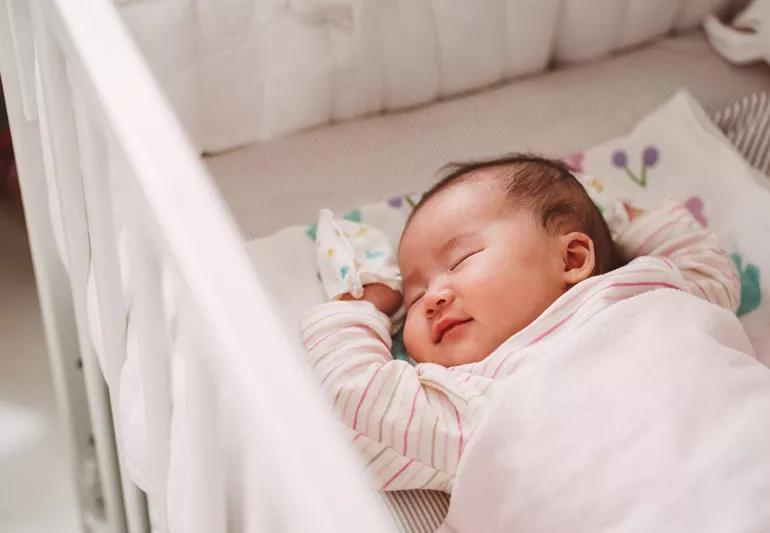Proven dangers of padded bumpers led to a 2022 ban

Padded crib bumpers certainly seem like a good idea. What baby wouldn’t like sleeping within a cozy ring of plush padding, right? Plus, cute designs on the bumpers offer a much better visual than wooden rails.
Advertisement
Cleveland Clinic is a non-profit academic medical center. Advertising on our site helps support our mission. We do not endorse non-Cleveland Clinic products or services. Policy
There’s only one problem: Crib bumpers can be deadly — the reason why they’re now banned in the United States. The Safe Sleep for Babies Act signed into law in May 2022 prohibits the future manufacture or sale of padded crib bumpers.
Of course, that legislative action doesn’t do anything about the millions of crib bumpers previously sold and currently in use.
If a baby-used crib in your house still features padded bumpers, the recommendation is to take them out. Pediatrician Heidi Szugye, DO, IBCLC, explains why removal should be at the top of your to-do list.
Padded crib bumpers can cause suffocation, strangulation and entrapment, and there’s a heartbreaking statistic to prove it: The U.S. Consumer Product Safety Commission (CPSC) connected 113 infant deaths to padded crib bumpers between 1990 and 2019.
To many, that tragic tally isn’t a surprise.
The American Academy of Pediatrics (AAP) advised caregivers against using padded crib bumpers in 2011 given the potential danger. That action followed a 2007 study that outlined the hazardous properties of the product.
“There’s no question they can be harmful,” says Dr. Szugye. “For years, you saw crib bumpers marketed as safe for sleep. They are not.”
Advertisement
The federal ban doesn’t include non-padded mesh crib liners. But Dr. Szugye recommends staying away from all bumper products given they serve no real benefit while adding risk.
The Safe Sleep for Babies Act also put a “banned hazardous product” label on inclined sleepers for infants. These sleepers — which incline at a slope greater than 10 degrees — have been found to pose a suffocation risk.
The CPSC reported 73 deaths among 1,108 incidents involving inclined sleepers between 2005 and 2019. Testing by the agency found no inclined sleeper safe for infant sleep.
Before the ban, inclined sleepers were involved in numerous product safety recalls.
OK … take a deep breath. After all of that information on dangerous sleeping conditions, let’s focus on how your baby can safely snooze.
“Safe Sleep” recommendations by the AAP always begin the same: Place your baby on their back to sleep. “Make sure to do this,” advises Dr. Szugye. “There’s no question it’s the safest way for your child to sleep.”
The push to have babies sleep on their backs began in the 1990s. The movement led to an immediate drop in sleep-related deaths and sudden infant death syndrome (SIDS).
Other AAP suggestions related to cribs and sleeping include:
“Your baby’s sleep position and sleeping environment always matter, whether it’s for a nap or at night,” stresses Dr. Szugye. “Following these recommendations is a simple way to reduce the risk of SIDS or other sleep-related death.”
Advertisement
To hear more from Dr. Szugye on this topic, listen to the Health Essentials Podcast episode, “Babies and Bedtime.” New episodes of the Health Essentials Podcast are available every Wednesday.
Advertisement
Learn more about our editorial process.
Advertisement

Your child may be ready if they’ve outgrown their crib or keep escaping it, or if they seem mature enough to make the switch

Babies can be noisy little sleepers! Blame small nasal passages and short sleep stages

Experts recommend having infants sleep in your bedroom but not in your bed

This sleep training method can bring quick results, but it may be stressful for parents

Help children get their needed rest by teaching good sleep hygiene, using mindfulness techniques and creating a calming environment

This technique involves picking up your baby to soothe them if they fuss or cry, but then, returning them to their crib before they fall asleep

Also known as graduated extinction, ‘Ferberizing’ teaches your child to self-soothe and fall asleep on their own

This technique can initially take a lot of time and patience, but it can also comfort your child as they learn to fall asleep on their own

Babies can get congested easily, but you can calm their cough by keeping them hydrated, using nasal drops and running a humidifier

Weight loss may cause loose, sagging skin and muscle loss to your rear

Several conditions, like vitiligo and fungal infection, can cause a loss of pigmentation, leading to white spots or patches on your skin